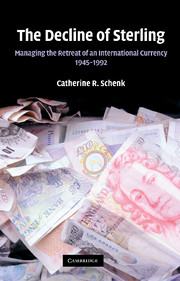Book contents
- Frontmatter
- Contents
- List of figures
- List of tables
- Acknowledgements
- 1 Introduction
- Part I Reconstructing the International Monetary System 1945–1959
- Part II Accelerating the Retreat: Sterling in the 1960s
- Part III Sterling's Final Retreat 1970–1992
- 9 Sterling and the end of Bretton Woods
- 10 Years of crisis 1973–1979
- 11 The aftermath 1980–1992
- 12 Summary and overview
- Index
10 - Years of crisis 1973–1979
Published online by Cambridge University Press: 04 May 2010
- Frontmatter
- Contents
- List of figures
- List of tables
- Acknowledgements
- 1 Introduction
- Part I Reconstructing the International Monetary System 1945–1959
- Part II Accelerating the Retreat: Sterling in the 1960s
- Part III Sterling's Final Retreat 1970–1992
- 9 Sterling and the end of Bretton Woods
- 10 Years of crisis 1973–1979
- 11 The aftermath 1980–1992
- 12 Summary and overview
- Index
Summary
During the first two post-war decades the pegged exchange rate system was viewed as a necessary foundation for a smoothly functioning international economy. Politically, pegged rates did bring states together to promote coordination over their common interest in the management of the system. Economically, fluctuating exchange rates were deemed to increase uncertainty and add to the costs of international transactions and thereby inhibit global growth. As the 1960s progressed, the repeated shocks to confidence as exchange rates were forced to adjust, often under considerable market pressure with attendant overshooting, led to greater support for a more flexible structure, either through crawling pegs, wider ranges of fluctuation or floating. Chapter 9 showed how the strains in the system often generated conflict between states rather than cohesion, particularly in the case of France and the United Kingdom within Europe and between the United Kingdom and the United States.
The end of the constraints of the pegged rate system did not deliver greater cohesion or eliminate pressures on domestic economic adjustment. In Cooper's famous phrase, this was partly due to the ‘size of the bumps in the road as well as the quality of the shock absorbers’ during the 1970s. The new system had to cope with a series of challenges, including a commodity boom followed by two oil price shocks and the accumulation of huge sovereign debt burdens by developing countries. The oil crisis transformed the nature of sterling as a reserve currency, as it generated large accumulations by oil-producing countries while other countries ran down their reserves.
- Type
- Chapter
- Information
- The Decline of SterlingManaging the Retreat of an International Currency, 1945–1992, pp. 357 - 395Publisher: Cambridge University PressPrint publication year: 2010



